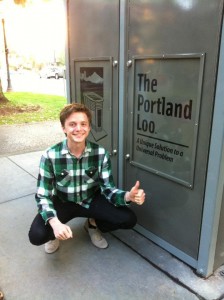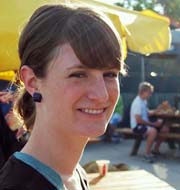The Tallman and the Two-Headed Goat
William Sercombe
Natural hazards big and small occur throughout every county in Oregon. Each county has its own specific hazards and vulnerabilities which is why each has their own mitigation plan. This plan also known as a Natural Hazards Mitigation Plan is what brought me within feet of the Marlboro-Man-styled “Tallman,” of Lakeview, Oregon.
My Resource Assistance to Rural Environment (RARE) placement has me working under Oregon Partnership for Disaster Resilience (OPDR) program specialist Michael Howard. Last week Michael and I traveled southeast to the cities of Burns and Hines in Harney County and the “Tallest Town in Oregon” – Lakeview — in Lake County. I had never been to this part of the state and my only preconception is from my mother who raved about a two-headed goat skull on display in the Burns Museum. Sadly, I never saw the goat skull; my time was primarily spent in meetings. Both Lake and Harney County are in the process of updating their Natural Hazards Mitigation Plan (NHMP). OPDR’s role in this is to create a coalition of public and private stakeholders and use their knowledge to draft an NHMP update complete with an updated community profile, hazard risk assessments, and hazard-specific action items among other things. Both counties’ previous plans are expiring in the next couple months and the update will provide eligibility to FEMA funded grant money for the next four years.
I concede that if not for this position I may not have ever traveled through two of the least populated counties of Oregon, whose cow-to-person ratio may be over 20:1. As a born and raised Oregonian who seldom leaves the Willamette Valley I now believe that there is a vast amount of Oregon I still have to explore. The thirteen hour round-trip was eye opening. We found ourselves taking pictures as often as tourists, impressed by the intricate geological formations and vast flat expanses. Through the car window, I became aware of the different natural hazards this part of the state poses. With nearly one third of the annual rainfall as Eugene the semi-arid landscape is much more prone to wildfire and drought. Stepping out of the car to snap a picture was met with winter temperatures that were as low as single digits at one point during our visit — winter storms are also a dangerous hazard. These specific hazards are what Michael, the OPDR team, and I must consider when drafting an NHMP plan. As these plans come due in the next couple months I hope to check back in, if at least to give detail to the two-headed goat.
Willy Sercombe received his undergraduate degree from the University of Oregon last spring in Planning, Public Policy, & Management and Political Science. A Eugene native, Willy was born a few blocks from the university campus at the Sacred Heart Hospital. Willy’s favorite past time is playing chess and he hopes to revitalize the Emerald City Chess Club. Willy aims to attend graduate school in 2015 in city planning with an emphasis in urban redevelopment and active transportation planning.
Willy now serves as the Resource Assistance to Rural Environments (RARE) Participant for the Oregon Partnership for Disaster Resilience (OPDR). His current projects involve updating the Natural Hazard Mitigation Plans of several Eastern Oregon counties.
More about the Resource Assistance to Rural Environment (RARE)
More about the Oregon Partnership for Disaster Resilience (OPDR)



